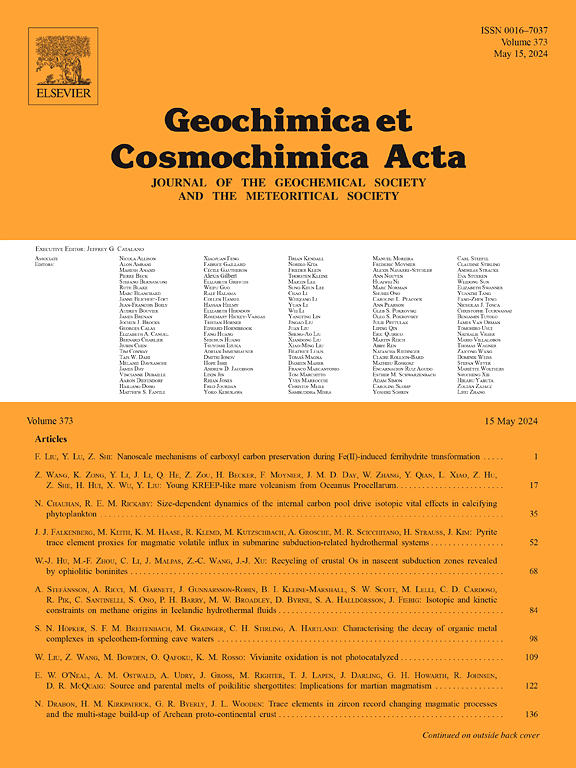重新评估磷在橄榄石中的扩散性:低扩散流动性对热年代学的影响
IF 4.5
1区 地球科学
Q1 GEOCHEMISTRY & GEOPHYSICS
引用次数: 0
摘要
与其他成分异质性相比,橄榄石中磷(P)含量的异质性对扩散均质化具有相对较强的抵抗力。因此,磷的空间分布异质性可以保留橄榄石晶体结晶最早阶段的岩石学信息,否则这些信息就会被消除。然而,与缓慢冷却岩石中长期冷却时间尺度的独立测定结果相比,P 的富集非常尖锐,表明其扩散流动速度比以前认为的要慢很多个数量级。在这里,我们将具有明确P异质性(在0.5微米的空间范围内,P2O5含量为0.02-0.15 wt%)的单个天然橄榄石晶体放在一个1大气压的气体混合炉中,在1400°C的温度下加热10-20天,从而使它们暴露在根据已公布的P扩散值应足以使其完全扩散弛豫的条件下。然而,对加热前后的同一内部切片进行高精度化学分析后发现,磷浓度模式的锐度没有明显差异。因此,目前应用于橄榄石中骨架磷富集的扩散计时法提供了错误的短扩散时间尺度。我们讨论了造成这些差异的几个可能原因,以及应用于橄榄石中磷的扩散时间测定法的影响。本文章由计算机程序翻译,如有差异,请以英文原文为准。
Re-evaluating the diffusivity of phosphorus in olivine: Implications of low diffusive mobility for thermochronology
Heterogeneities in the phosphorus (P) content of olivine are relatively resistant to diffusive homogenization when compared with other compositional heterogeneities. Thus, heterogeneities in the spatial distribution of P can preserve petrological information about olivine crystals from the earliest stages of crystallization which have been otherwise eliminated. However, compared to independent determinations of protracted cooling timescales in slowly cooled rocks, P enrichments are so sharp as to suggest a rate of diffusive mobility that is many orders of magnitude slower than previously suggested. Here, we heat single natural olivine crystals with sharply defined P heterogeneities (0.02–0.15 wt% P2O5 over 0.5 μm spatial scale) in a 1-atmosphere gas-mixing furnace for durations of 10–20 days at 1400°C, thus exposing them to conditions that should be sufficient for complete diffusive relaxation according to published P diffusivity values. However, high-precision chemical analysis of the same interior section before and after heating reveals no discernable difference in the sharpness of phosphorus concentration patterns. Therefore, diffusion chronometry applied to skeletal P enrichments in olivine currently provides erroneously short diffusive timescales. We discuss several possible causes for these discrepancies and the implications for diffusion chronometry as applied to phosphorus in olivine.
求助全文
通过发布文献求助,成功后即可免费获取论文全文。
去求助
来源期刊

Geochimica et Cosmochimica Acta
地学-地球化学与地球物理
CiteScore
9.60
自引率
14.00%
发文量
437
审稿时长
6 months
期刊介绍:
Geochimica et Cosmochimica Acta publishes research papers in a wide range of subjects in terrestrial geochemistry, meteoritics, and planetary geochemistry. The scope of the journal includes:
1). Physical chemistry of gases, aqueous solutions, glasses, and crystalline solids
2). Igneous and metamorphic petrology
3). Chemical processes in the atmosphere, hydrosphere, biosphere, and lithosphere of the Earth
4). Organic geochemistry
5). Isotope geochemistry
6). Meteoritics and meteorite impacts
7). Lunar science; and
8). Planetary geochemistry.
 求助内容:
求助内容: 应助结果提醒方式:
应助结果提醒方式:


